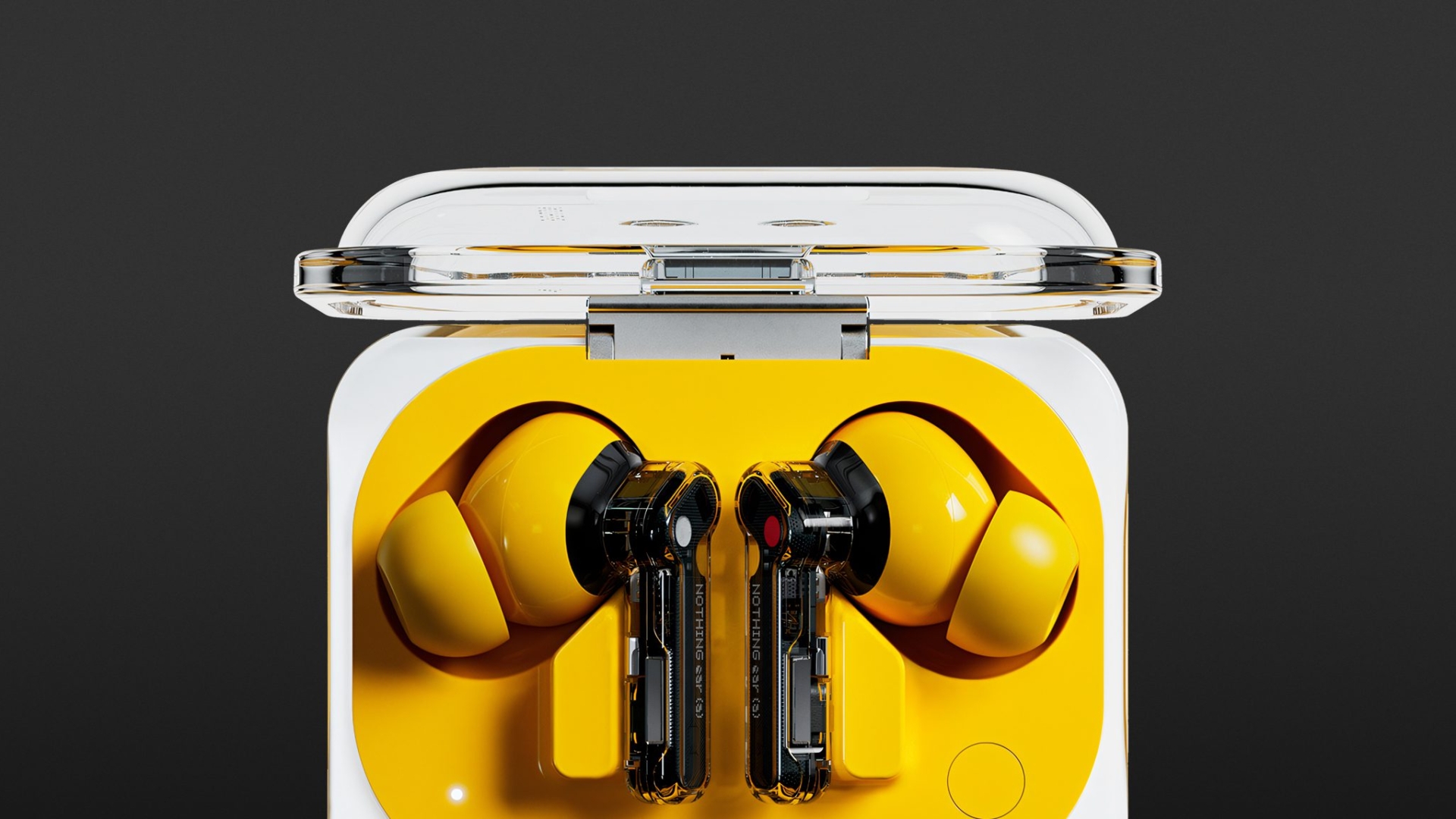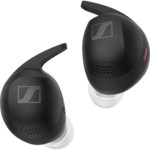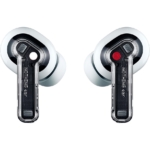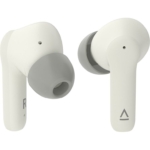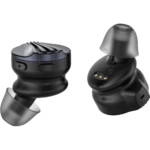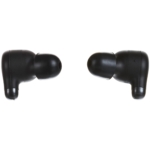The Nothing Ear (a) is designed for modern, powerful sound reproduction, which can be easily customised to suit your own preferences using the adjustable bass enhancement function. Automatic analysis of the ear canal also enables optimised noise suppression, while the AI-supported microphone technology is designed to ensure clear, distinct voice transmission.
- Comfortable fit
- Earpiece with IP54 certification, case with IPX2 certification
- Fast charging function
- Multipoint connections
- Low-lag mode
- Adjustable bass enhancement function
- Support AAC and LDAC
- No manual on/off switching possible
- No USB adapter included
Visually, the up and coming London-based company remain consistent and the Nothing Ear (a) with its transparent design integrates seamlessly into their existing portfolio.
However, the charging case is significantly more compact than the one that comes with the Nothing Ear and has a much more pocket-friendly format thanks to the rounded edges. It also fitted very comfortably in my hand.
The case weighs just 40 grams and fulfils the requirements of protection class IPX2, while the in-ears are dust and water-resistant to IP54. As with the earlier model, they have a stable, comfortable fit that makes it possible to take part in sporting activities. However, a new development here is that the Nothing Ear (a) is also available in yellow in addition to the familiar white and black options.
In terms of sustainability, the manufacturer states that they use fully recycled tin solder paste in production, and the final assembly is carried out using renewable energy. The headphones are also delivered in plastic-free packaging.
Comparison: Nothing Ear and Nothing Ear (a)
In contrast to the third generation of the Nothing Ear, this model supports LDAC, a high-resolution audio codec, but not LHDC 5.0. You will also have to make do without an individual sound profile and the additional 8-band equaliser with a sharing function for pre-sets. The slimmer charging case of the Nothing Ear (a) is also not dustproof and can only be charged via cable, not wirelessly via Qi. With that said, the wireless connection seemed more stable during our test than with the higher-priced model. In comparison with the other version, the Nothing Ear (a) also performed slightly better in terms of battery life.
Battery life
These True Wireless in-ears can achieve a listening time of nine hours per charge at a high volume when the AAC codec is used. If noise cancellation was permanently active, however, a good five hours was more realistic. It is possible to fully charge the headphones in the case three times and once more with a residual of four hours, resulting in a total runtime of up to 40 hours in standard mode and around 23 hours in ANC mode. A ten-minute quick charge provides capacity for two and a half hours, but fully refuelling the in-ears takes around 60 minutes when the batteries are empty. The case’s reserve is restored after 75 minutes, and a USB-C charging cable is supplied so you can do this. However, a USB adapter is not included with the headphones.
Bluetooth specs
In addition to Bluetooth 5.3, the Nothing Ear (a) supports SBC, AAC and LDAC audio codecs. The features also include Microsoft Swift Pair and Google Fast Pair for fast pairing, as well as multipoint connections that allow you to use them with two devices simultaneously. Thanks to a stable wireless connection, they can cover a large area, which means around 30 metres outside in the garden. Indoors, several rooms can be covered and it is possible to change floors.
Operation
A pressure-sensitive touch control is used to start and stop playback, make phone calls and skip forwards and backwards when selecting tracks. It is also possible to switch between ANC and transparency mode, which can be expanded to include basic mode via the app. Volume control and voice assistants can also be retrofitted, which means that in combination with a Nothing Phone (2), the Nothing Ear (a), like the Ear model, can optionally integrate Chat GPT. This integration will also soon be available for the Nothing Phone (1) and (2a).
However, the touch control on the Nothing Ear seems to have a better feel, making it easier to use these controls everyday use. This was due to a narrower notch in the stem, which offers less orientation for the fingers on the Ear (a). It’s not possible to switch the earphones on and off via the touch control, and this applies to both models. However, one-sided use in single mode is possible. The in-ear wear detection function, which can be flexibly activated and deactivated via the app, worked reliably and without any major delays.
Nothing X app
The app’s noise control (for Android and iOS) is divided into a general transparency mode and several operating modes for noise cancelling. There are three static ANC modes to choose from for manual adjustment called “Low”, “Medium” and “High”, while the noise cancellation automatically adapts to the environment in the adaptive version.
The app also offers sound control via three axes for the lower, middle and upper-frequency range, although it is unfortunately not possible to save your own settings as pre-sets. However, three preconfigured settings can be used: “More bass”, “More treble” and “Voice”.
In addition, an adjustable bass enhancement algorithm is available; this analyses the audio material in real-time and boosts the bass range as desired, and can be done through five intensity levels.
Other features in the app include a low-lag mode for mobile phones and computer games, a fit test and the option to perform firmware updates. A search function can also help you find the earphones using a ping feature.
Voice intelligibility when making calls
In a quiet environment, the Nothing Ear (a) offered clear and distinct voice transmission that was easy to understand. Communication was also easy with a busy background, as noises were purposefully attenuated, making it easy for the person on the other end of the line to follow your voice. Wind noise was also completely filtered out, although this might have a negative impact on voice quality, as the voice transmission was no longer smooth and arrived at the other end of the line as somewhat choppy.
Noise cancellation (ANC) and transparency mode
Overall, the noise cancelling was more reminiscent of the Nothing Ear (2) than the third generation and was not as effective as the previous model, especially in the mid-frequency range. Slight advantages in favour of the Ear could also be observed in the low and high-frequency range, but it was more noticeable that background voices were slightly attenuated. This was the case with every version, with the high ANC mode achieving the best results. However, given the price range, the noise cancellation offered solid attenuation.
Differences were also noticeable in transparency mode, with the Nothing Ear (a) offering a more intensive amplification of the outside world. Although the cheaper model had a slightly higher background noise, you might benefit from an increased perception of your surroundings when listening to music. In addition, transport announcements and the like could be heard better when playback was paused.
Sound – How good does the Nothing Ear (a) sound?
In the factory settings, the bass enhancement function was active at the third level, which meant that the Nothing Ear (a) offered a full, rich sound reproduction with a pronounced bass. The bass foundation was softer and not as crisp as with the Ear but more substantial so that the fun factor was definitely the focus. These headphones managed this very well, as the bass boost could easily and quickly be adjusted to different content thanks to the step system. The algorithm can also be switched off completely.
The warm mid-range conveyed a direct, forward sound impression and had assertiveness in mobile use. When listening at a reduced level, it was easy to discover details. Although vocal reproduction was by no means lean – indeed, it tended to be a little more full-bodied – spoken word content, as well as vocals and singing, did not appear too superficial or energetic.
This was coupled with a present treble reproduction, which did not drop off noticeably and opened up the sound image favourably, making the presentation seem neither cramped nor flat. In the normal listening range, accents were skilfully set with verve and freshness, whereas the upper registers might be perceived as somewhat harsher at higher volume levels.
Conclusion
The Nothing Ear (a) is particularly recommended for bass-emphasised media playback, the intensity of which can be controlled as desired using the multi-stage algorithm. The transparency mode also performed well, while the noise cancellation mainly attenuated the low and high-frequency range most effectively. The handy design proved to be practical, allowing these weatherproof True Wireless in-ears to be stowed directly in your pocket when travelling.
Technical specifications
- Ear couplingIn-ear
- Typeclosed
- Transducer principledynamic
- Weight without cable5g each, case 40 g
What's in the box
- Eartips in 3 sizes (S, M, L)
- USB-C charging cable
- Charging case
Special features
- Available in black, white and yellow
- BT codecs: SBC, AAC, LDAC
- BT version: 5.3
- BT profiles: RFCOMM, SPP, HFP, A2DP, AVDTP, AVCTP, AVRCP









